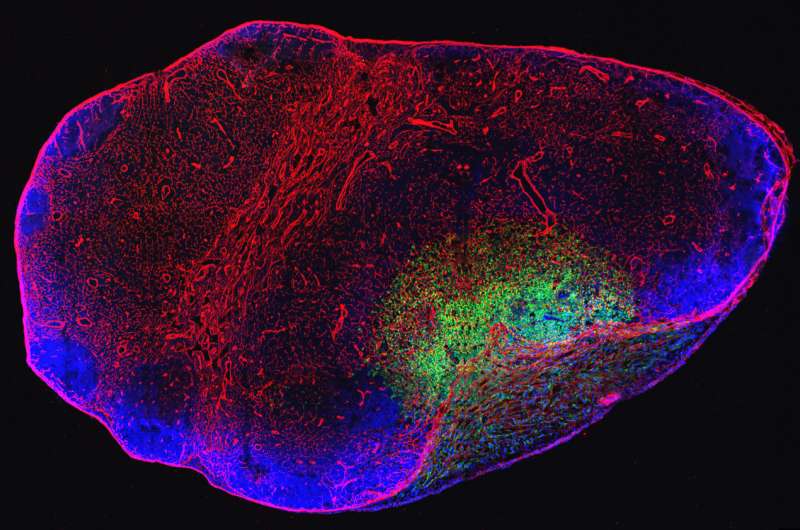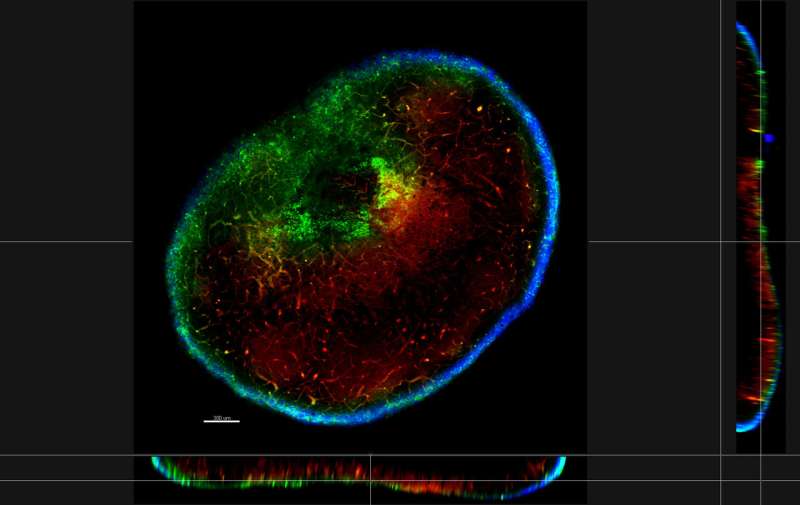Metastatic lymph nodes can be the source of distant metastases in mouse models of cancer

A study by Massachusetts General Hospital (MGH) investigators finds that, in mouse models, cancer cells from metastatic lymph nodes can escape into the circulation by invading nodal blood vessels, leading to the development of metastases in other parts of the body. Their report appearing in the March 23 issue of Science adds evidence to the debate regarding the role of lymph node metastases in the spread of cancer.
"When cancer cells spread in the body, often the first place they travel is the lymph node that drains the site of the primary tumor, but there has been controversy around the ability of cells from the lymph nodes to spread to organs such as the lung, liver, bone and brain—sites where the spread of cancer is often fatal," says Timothy Padera, PhD, of the Steele Laboratories for Tumor Biology in the MGH Department of Radiation Oncology, senior author of the paper. "We directly showed that cancer cells that first spread to lymph nodes can invade blood vessels perfusing the nodes to become a source of tumors that grow in distant organs."
To investigate whether cancer cells from lymph node metastases can spread to other organs, the researchers labeled several different types of cancer cell—mouse versions of breast cancer, melanoma and squamous cell carcinoma—with a fluorescent protein that changes from green to red when exposed to a specific light. Primary tumors were generated by implanting the labeled cells into mice, and when lymph node metastases developed, metastatic cancer cells were converted from green to red fluorescence. Red cancer cells found in the circulation or elsewhere in the body could have come only from the metastatic lymph node and not the primary tumor.

The research team detected red circulating tumor cells in the animals' bloodstreams, indicating that cancer cells were being released from the metastatic lymph nodes. They also found red cancer cells in the animal's lungs, supporting the hypothesis that cells from lymph node metastases can form new metastatic colonies in the lungs or other organs. Close examination of metastatic lymph nodes from the mice in this study suggested that metastatic cells within lymph nodes move toward and into blood vessels by means of conduits through which immune cells travel through the nodes. Similarly, in lymph nodes from patients with head and neck cancer, tumor cells could be identified in lymph node blood vessels.
"If these data are confirmed in human patients, they would suggest that some lymph node metastases could be the source of fatal distant metastases and would need to be definitively treated," says Padera, who is an associate professor in Radiation Oncology at Harvard Medical School. "Defining the molecular control of how cancer cells within lymph nodes can invade lymph node blood vessels would enable the therapeutic targeting of that process, and characterizing the molecular profiles of the cells that escape the nodes could identify markers signifying which nodes are dangerous and need to be definitively treated to cure the patient."
More information: E.R. Pereira el al., "Lymph node metastases can invade local blood vessels, exit the node, and colonize distant organs in mice," Science (2018). science.sciencemag.org/cgi/doi … 1126/science.aal3622

















